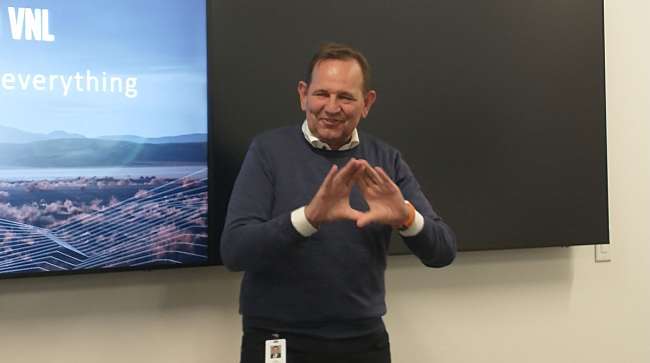Staff Reporter
Volvo’s Voorhoeve: Customer Service Integral to Company

[Stay on top of transportation news: Get TTNews in your inbox.]
Over a quarter century ago, Volvo Trucks welcomed Peter Voorhoeve to the ranks of its employees. And Voorhoeve contends the lessons learned in customer service in the last couple of years of the 20th century stay with him to this day.
Voorhoeve is president of Volvo Trucks North America, the most senior executive at the truck maker, a role he has held since 2018. But his first post within Volvo Group, upon moving over from Belgian firm Devriendt Recycling in 1998, was as Volvo Action Service general manager.
Volvo Action Service offers customers help with roadside assistance and repairs, towing, in-house warranty filing, customer advocacy and dealing with general inquiries.
In North America, all customer care is managed from the Volvo Uptime Center in Greensboro, N.C., with every employee in the same building.
Looking good even when no one is looking. #AllNewVolvoVNL pic.twitter.com/VAQdqXzQpC — Volvo Trucks North America (@VolvoTrucksNA) November 20, 2024
Indeed, everyone in the company’s aftermarket group is based in the same Uptime Center building.
Those departments comprise warranty administration, bodybuilder support, parts specifications, technology support, reliability, Volvo Action Service, training facility, information technology helpdesk and ECU programming.

Roy
The concept of all employees under the same roof was created by current Mack Trucks President Stephen Roy, who headed the aftermarket teams for both Mack and VTNA between 2008 and 2013.
Voorhoeve told a group of reporters touring the Uptime Center that Volvo spends a lot of time training its staff at the facility on how to help out the stressed customers on the other end of the phone line.
“There’s a bit of an art to this,” he said, adding that what the employees must try to convey is that they are here to help and plan to get the customer moving quickly again.
And positions at the Uptime Center will continue to be extremely important, even a quarter century from now, the company’s top executive said.
Looking good even when no one is looking. #AllNewVolvoVNL pic.twitter.com/VAQdqXzQpC — Volvo Trucks North America (@VolvoTrucksNA) November 20, 2024
In 25 years, there still will be drivers, Voorhoeve said, even as VTNA prepares for the launch of commercial operations of the VNL Autonomous tractor and the impacts of self-driving trucks on the freight sector.
The first route for the factory-equipped VNL Autonomous semis will be between Houston and the Dallas-Fort Worth metropolitan area. Volvo Autonomous Solutions has an operations center in Fort Worth, and executives expect a whole new transportation ecosystem.
There will be a lot more autonomous trucks in 25 years, said Voorhoeve, but self-driving trucks will be largely working repetitive routes.
Change will come to customer support, too, over the next quarter century, he said, with smaller teams, more problems handled by artificial intelligence and many fewer breakdowns in general due to improved connectivity and diagnostics advances.

De Souza
Uptime, safety and fuel efficiency are the top three issues for customers, according to Chayene De Souza, product marketing manager-connected solutions.
The remote diagnostics available on VTNA’s redesigned flagship VNL semi cuts diagnostics time by 70%, has a 97% success rate and saves 22% in repair time, De Souza said during a presentation at the Uptime Center.
Launched in January, the VNL’s connectivity advances include E-Call, a self-activating crash notification system; a fully integrated electronic logging device; the Volvo Connect fleet management portal, where diagnostics can be assessed and monitored; the My Truck app; and two years of Volvo Uptime Care.
One unplanned day of downtime has an average cost of $1,500, but could cost as much as $30,000, Conal Deedy, VTNA customer productivity solutions director, told reporters.

Deedy
Remote diagnostics and programming are part of minimizing downtime, Deedy said. “It’s just like your phone; [the truck is] not going to work as well if you don’t do the updates.”
The programming can be applied to one truck or to many, he said, and is guaranteed to take less than 30 minutes and usually around seven.
A couple of uses could be to increase the maximum speed to take advantage of lower fuel prices and/or reducing the maximum speed in response to speeding tickets, he said.
VTNA has two decades of collected data for trucks to drill down into for any of these options. In North America, Volvo Trucks has built 532,000 connected trucks.

Portelllo
“It’s a way to stay connected with customers,” said Chief Digital Officer Nicole Portello at VTNA and Mack, in essence a customer satisfaction tool.
Customer satisfaction will be paramount to VTNA because the company is looking to boost its Class 8 market share to 15% by 2030 from around 10% currently.
“Our ambition is for Volvo Trucks to have a 15% market share in North America. And it will happen,” Volvo Trucks President Roger Alm said Nov. 14 during a Volvo Group Capital Markets Day.
VTNA won a 10% share of Class 8 retail sales in 2023, according to Wards Intelligence data. Mack Trucks captured a 6.8% share, but is looking to boost that to 10%, including through the launch of a new flagship semi in 2025, according to Roy.
Want more news? Listen to today's daily briefing below or go here for more info:




